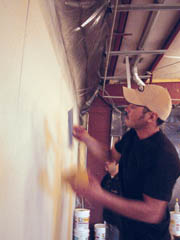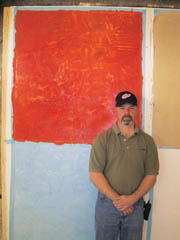
Although a comment in relevance to the artists-not the tradesmen-of painting, Mark Rothko's (modern artist, contemporary of Jackson Pollock) quote is a valid point that can be applied within the context of the arts and crafts of the plasterers' world. It addresses quality, knowledge and substance. Reviewing the works of this particular artist reminds this writer of faux and finish coatings, due in large part to both Rothko's color scheme and patterns found in his canvasses.
In February, Walls & Ceilings attended a training program, which strongly emulate the finishes akin to this style of painting, which focuses on form, shape, color and texture. Held in Houston, Permatone's Platinum Certification Program is a three-day course (and held monthly) aimed at expanding the hand-trowel workers' and painting contractors' skills to decorative finish systems and better craftsmanship, altogether. The attendees were either local or national contractors that were traditional plaster, drywall, EIFS/stucco applicators or painting contractors.

Colored landscape
The Permatone family of finishes are acrylic-modified finishes that include Venetian plasters and other like finishes but work under a different science than traditional plaster. Rather than mixing the lime and Paris plaster, these coatings (with exceptions) can be used directly from the company's pre-mixed line. The line includes a wide spectrum of finishes and aims at delivering the right look for a broad range of budgets and tastes.On day one, the course began with an overview of the company, its products and the art of the trade. To ensure the bilingual attendees were not lost in translation, training instructor Victor Gomez translated the entire program in both English and Spanish. Held in an empty working space with mock walls hung with gypsum board, the class began with an overview of its substrate conditioners, which were eventually applied on all the walls.
To introduce the Traditional Finishes, the first coating worked on was with the product QuartzSilco (which is the material to create something similar to a "knockdown" pattern), a finish formulated with integral coloring, silica fillers and chemical additives. To achieve this pattern, the students (as the attendees will be referred to) used a hopper gun in circular motions to apply the material as evenly as possible onto the walls that were primed with the Pintufondo product in the base color of choice. The tip size and air pressure can be adjusted depending on how thick the texture is wanted. Once the material is set (10 to 15 minutes approximately), the class each used a trowel to shave off and smooth excess material. From there, the surface is floated, running the hand tool in up and down motions. Some commonly known finishes are the Fino, Damascus, Rustic Stone and Antique Stone.
The QuartzMural product can be manipulated to resemble a variety of textures, though the class focused on a wood grain, crisscross or swirl texture. Again, the surface should first be primed with the same material but allow it to dry for at least 12 hours. Armed with a stainless steel trowel, the class applied the QuartzMural onto the wall at a 10 to 15 degree angle, excess material immediately removed. To achieve these textures, the surface is floated with an acrylic trowel. This tool will cause the larger aggregates to move through the finish, which creates the texture. The use of hand and arm movement dictates the final texture. While creating this finish, it is important to consistently wipe and clean the trowel so excessive material doesn't exaggerate texture marks.
Expressionism
On day two, the class worked on several different finishes, which are classified as the Venetian Collection. The day began with the Palladio finish, probably the most overt decorative finish the company offers. As a Venetian finish with a polished marble appearance, it is a highly dramatic coating requiring multi steps. This finish requires a stainless steel trowel with rounded corners or beveled edges, flexible metallic spatula and #320 and #400 grid sandpaper. To begin, hand-mix the Palladio until its material is homogeneous.Using the stainless steel trowel, skim the surface with the CorevMix undercoat, allowing it to dry for 12 hours. Then, using very fine paper, smooth out the entire surface, dusting off the surface with a moist cloth. With the spatula or a small trowel, apply the Palladio on in very small strokes, troweling the material in different directions that overlap one another. Each coat applied should not be more than 7 to 9 millimeters in thickness (there should be at least two coats). With the #400 grid sandpaper, smooth out any imperfections in the texture. Let the coats dry 12 hours before applying additional ones.
No other finish that the class experimented with varied more in style and tone than this finish. What makes the polish flourish is by taking the stainless steel trowel's edge and pressing down, and sliding it over the surface at a 5 to 10 degree angle. The more this is done, the brighter the surface. The Marmolino product is also applied using the same techniques with the exception of the rhythm of the strokes.
The Craquelatto product and finish is as much science as art. With a hawk and trowel, or mud knife and a pan, apply Craquelatto to a thickness of 1/8-inch thick. The trowel movement and material pattern need to be random and contain no straight lines. The resulting application looks like frosting on a cake and the irregular surface promotes the random cracking. The class was taught by Gomez to use short strokes in different directions to deflect the formation of continuous trowel marks.
Then, to achieve the cracked surface, use a fan (on high if oscillating) over the applied surface to dry the wet material. The splitting will begin 15 to 30 minutes after application. To fully achieve this technique, make sure room temperature is approximately 77 degrees F with the humidity low.
The third and final day of the training course introduced the Faux Finishes and the company's coatings that are designed to achieve this look.
The Castello is a low viscosity water-based acrylic glaze and can also be used for exterior finishes. To achieve this coating, the required tools are a paint brush, chamois and regular paint rollers, marine sponge, cloth, spray equipment, plastic roller and/or other materials that help create faux effects.
After priming the surface wall, mix the product manually or use a low rpm mix. With the chamois roller, apply the product with a 1/4-inch nap roller, with a second applicator that simultaneously rolls the roller multiple times over the surface, and in differing directions, resulting in a uniform texture and pattern. With a chamois trowel or sponge, apply the product at the same thickness using the same roller, with the second applicator dabbing the wet material with a chamois trowel or sponge to create a similar detail. When using the roller, trowel and sponge, be sure to constantly clean the tool to avoid excessive build up of material. The result of this texture should be a translucent satin effect with some contrast between the color and depth. Riflexi, a metallic glaze with pearlescent luster, was applied using similar techniques as with Castello.
All of these finishes were created as an alternative to traditional plaster. Acrylic coatings, though still considered in its beginning stages, are already finding a market within the plastering, drywall and painters trade. This is why such seminars, such as the Platinum Certification Program exist-to encourage strong craftsmanship, aesthetic awareness and responsible building.


Report Abusive Comment